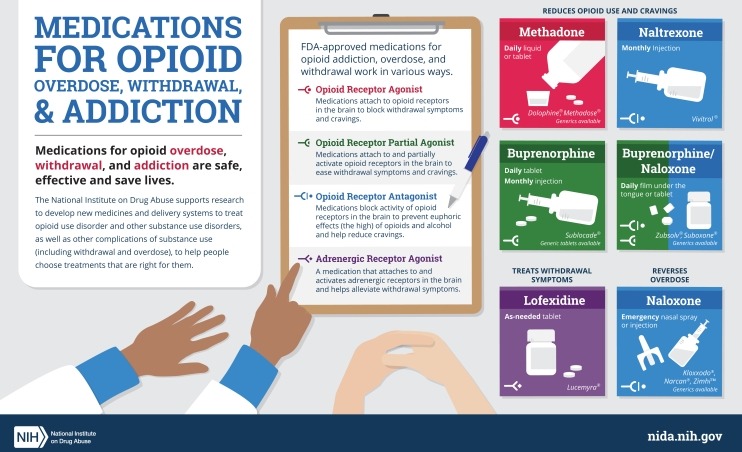Medications for opioid use disorder are safe, effective, and save lives. This NIDA-produced video takes a closer look at these medications and how they work.
Video length: 3:55
Transcript
This video shows different types of medications approved by the U.S. Food and Drug Administration for opioid overdose, withdrawal, and addiction. This video is intended to present basic information on common medications and formulations available to consumers. For comprehensive information on all available medications for patients and health professionals, please visit the FDA's webpages on medications for opioid use disorders and opioid overdose reversal medications. Additional information on medications for substance use disorders is available from the U.S. Substance Abuse and Mental Health Services Administration.
[Female Voice-over]
Opioid use disorder is a chronic but treatable condition. Several medications can help support recovery and improve health by reducing cravings, easing withdrawal symptoms, and even reversing an opioid overdose. These medicines are safe, effective, and save lives. Medications for opioid use disorder can be used alone or as part of a larger treatment plan. Each medication works in a slightly different way, but they all fit into very small cellular structures in the brain called receptors—sort of like a lock and key. Here’s a closer look at medications for opioid use disorder and how they work.
NALOXONE (On screen)*
Naloxone is a medication that can save a life in the event of an opioid overdose.
When given right away, naloxone works in minutes to reverse an opioid overdose by kicking the opioids off opioid receptors in the brain.
This stops opioids from continuing to cause dangerous effects—like slowing or stopping breathing.
There are two forms of naloxone – injectable and nasal sprays.
Anyone can carry naloxone. In many areas, these emergency medications are available at pharmacies without a prescription.
LOFEXIDINE (On screen)
Lofexidine is a tablet that can be used as needed to ease withdrawal symptoms as someone stops taking opioids and the drugs begin to clear completely from their body.
This is a process some people call detoxing.
Lofexidine attaches to and activates certain receptors, called adrenergic receptors, in the brain.
This relaxes parts of the nervous system to alleviate the nausea, cramping, and flu-like symptoms associated with opioid withdrawal.
BUPRENORPHINE (On screen)
Buprenorphine is an opioid medication that attaches to opioid receptors in the brain but activates them only partially.
In this way, buprenorphine helps reduce opioid cravings and ease withdrawal symptoms in people with opioid use disorder without producing the same high as other opioids.
Buprenorphine is a monthly injection** or daily tablet that dissolves under the tongue.
Buprenorphine may be combined with the medication naloxone in a single daily tablet that dissolves under the tongue or small film that sticks to the inside of the cheek and dissolves.
METHADONE (On screen)
Another medication, methadone has been used successfully for more than 40 years to treat opioid use disorder.
It comes in a liquid or a tablet and is taken daily at a treatment center.
Methadone is an opioid medication with slower and more stable effects than other opioids.
This medication doesn't produce a high in people with opioid use disorder. This allows methadone to ease withdrawal symptoms, curb cravings, and support recovery.
NALTREXONE (On screen)
Naltrexone is a monthly injection used to treat both opioid use disorder and alcohol use disorder.
Naltrexone blocks the activity of opioid receptors in the brain, preventing the high associated with these drugs and reducing cravings.
Naltrexone does not control withdrawal symptoms and is used after someone stops taking opioids or alcohol, and the drugs clear completely from their body.
Find the Right Treatment For You (On screen)
If you or a loved one has an opioid use disorder, talk with a health care provider to learn more about how medications can help.
For many people with opioid use disorder, medication can make life’s activities more doable – whether it’s finding time for themselves, doing well at work or school, or reconnecting with the people they love.
You can learn more about substance use treatment near you by calling the National HELPLINE [1-800-662-HELP(4357) on screen] or visiting FindTreatment.gov.
*Since this video was released, the U.S. Food and Drug Administration has approved a prescription nasal spray and injection formulation containing nalmefene to reverse opioid overdose (https://www.fda.gov/news-events/press-announcements/fda-approves-prescription-nasal-spray-reverse-opioid-overdose, https://www.fda.gov/drugs/postmarket-drug-safety-information-patients-and-providers/information-about-naloxone-and-nalmefene).
**Since this video was released, the FDA has approved a weekly or monthly injection formulation of buprenorphine (https://www.fda.gov/news-events/press-announcements/fda-approves-new-bu…).
